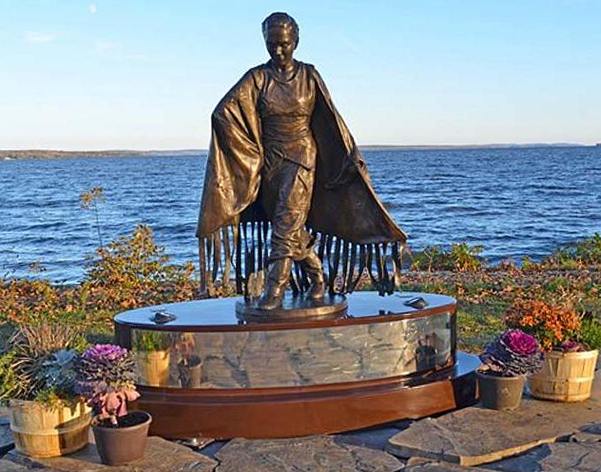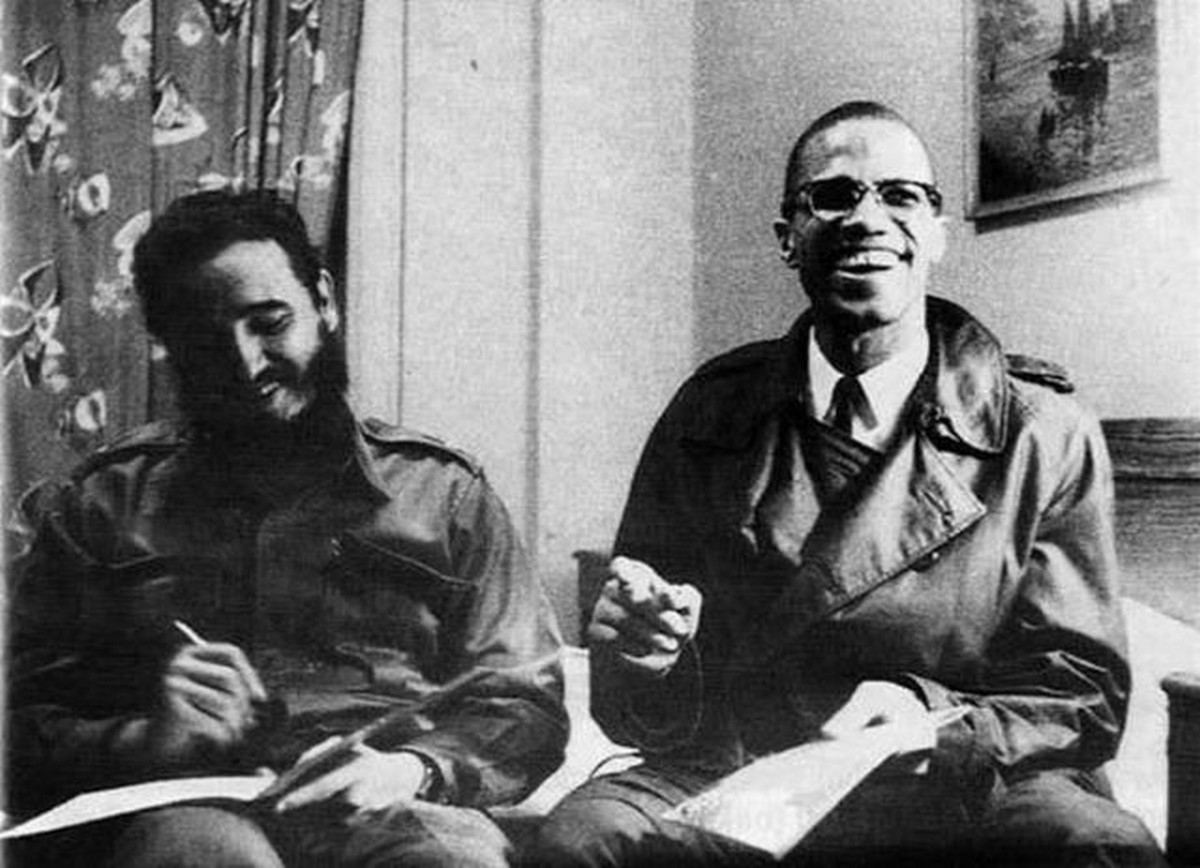
|
February 20, 2016 - No. 8 Diversionary
Discussion to
Hide the
Introduction
to
Wholesale
Trade Uphold
the
Hereditary,
Treaty
and
Venezuelan
Government
and
People
In
Action
to
Cuba's
Defence
of
the
Revolution
Predictions on the Economy Diversionary Discussion to Hide the
|
|
|
Based on data from the MWTS (excluding the three large industries mentioned), wholesalers sold an average of $52.9 billion worth of goods and held $65.9 billion in inventories per month in 2014. In comparison, on average, manufacturers sold $51.6 billion and retailers sold $42.1 billion worth of goods on a monthly basis during the same period.
The wholesale trade sector accounts for about 5% to 6% of gross domestic product (GDP), comparable with the retail trade sector. In 2014, wholesalers employed more than 775,000 people in an average month, or about 5.0% of all employees in Canada. In that year, on average, the wholesale sector employed a smaller share of people than the manufacturing sector (9.5%) and the retail sector (12.4%), but employed similar numbers to the finance and insurance sector (4.5%) and the transportation and warehousing sector (4.7%). People employed by wholesalers earned an average of $1,110 per week in 2014, approximately 19% higher than the national average of $935 per week and more than double that made by those working in retail trade ($542 per week).
In the area of capital spending, the wholesale sector accounted for 2.2% of non-residential building construction capital expenditures in Canada in 2013. This was a smaller amount than the shares of either the retail sector (9.6%) or the manufacturing sector (10.8%), but larger than the information and cultural industries sector (1.5%). In terms of capital expenditures on machinery and equipment, wholesalers accounted for 3.1%, similar to the retail sector (4.1%) but smaller than the manufacturing sector (13.1%).
In the same year, wholesalers accounted for 8.3% of total business enterprise research and development intramural expenditures, a far smaller share than manufacturers (42.1%), but a much larger share than retailers (0.4%).
What Do Canadian Wholesalers Do?
Wholesalers as intermediaries have relationships with most other sectors of the economy. The largest subsector in the MWTS in 2014 was the machinery, equipment and supplies subsector, with average monthly sales of $11.1 billion. Wholesalers in this subsector typically distribute machinery and equipment to a variety of businesses, including those in the construction, mining, forestry, and manufacturing sectors, as well as to farmers, retailers and public institutions. The machinery and equipment needed by Canadian businesses are sometimes manufactured in other countries, so it is common for wholesalers in this subsector to import the machinery and parts they sell.
|
|
Wholesalers in the food, beverage and tobacco subsector typically sell to retailers and restaurants, linking these companies with the farmers and manufacturers that produce the goods desired by their customers. In this subsector, wholesalers sometimes import the goods they sell, and sometimes export food harvested or manufactured in Canada to the rest of the world. This subsector sold an average of $10.2 billion worth of goods monthly in 2014.
In the motor vehicle and parts subsector, which had average monthly sales of $9.2 billion in 2014, wholesalers are involved in both exporting and importing motor vehicles, which range from automobiles to heavy duty trucks and buses, as well as their parts. These wholesalers sell their goods to a wide variety of businesses, including retailers.
The building material and supplies subsector is one of the smaller subsectors, with average monthly sales of $7.6 billion in 2014. Most of these wholesalers distribute goods to retailers, manufacturers and other businesses, but there are some that export commodities such as lumber.
The next largest subsector in 2014 was personal and household goods, with average monthly sales of $7.3 billion. With the exception of wholesalers in the pharmaceuticals and pharmacy supplies industry, wholesalers in this subsector typically import a large share of the goods that they redistribute. It is typical of wholesalers in this subsector to primarily sell to retailers.
Wholesalers in the miscellaneous subsector are a very diverse group, accounting for on average $6.8 billion in monthly sales in 2014. They sell a wide variety of products to a variety of businesses, including retailers, manufacturers and farmers, and several export their goods to foreign markets.
Finally, wholesalers in the farm product subsector, the smallest subsector covered by the MWTS with average monthly sales of $709 million in 2014, specialize in the distribution of items such as live animals and nursery stock, both within Canada and to foreign markets.
Looking at the industries excluded from the MWTS, wholesalers of petroleum and petroleum products primarily sell to other wholesalers, although they do sell to foreign firms, manufacturers and retailers too. Wholesalers in the oilseed and grain industry, similar to other wholesalers in the farm product subsector, frequently export their goods to foreign markets.
The smallest excluded industry, business-to-business electronic markets and agents and brokers, is a small but diverse group that are united by the fact that they do not own the goods they sell. Instead, they sell goods owned by others for a fee or commission.
What Does the Wholesale Trade Sector Look Like in Canada?
In 2014, the three largest components of wholesale trade on the MWTS were the machinery, equipment and supplies subsector; the food, beverage and tobacco subsector; and the motor vehicle and parts subsector. Together, these subsectors accounted for an average of 58% of monthly sales.
According to MWTS data, wholesalers are heavily concentrated in Ontario, which accounted for on average 49% of monthly wholesale sales in 2014. Quebec (18%), Alberta (13%) and British Columbia (10%) were the next largest provinces, together accounting for an average 41% of monthly sales in 2014, less than the share of Ontario alone. Wholesale sales in the Atlantic provinces and the territories combined accounted for on average 3.5% of monthly wholesale sales in Canada during the same period.
Overall, wholesale trade comprises a diverse group of
businesses that perform a variety of roles; they connect foreign
firms to domestic ones, and provide the links between farmers,
manufacturers, retailers, public institutions and other
businesses in Canada.

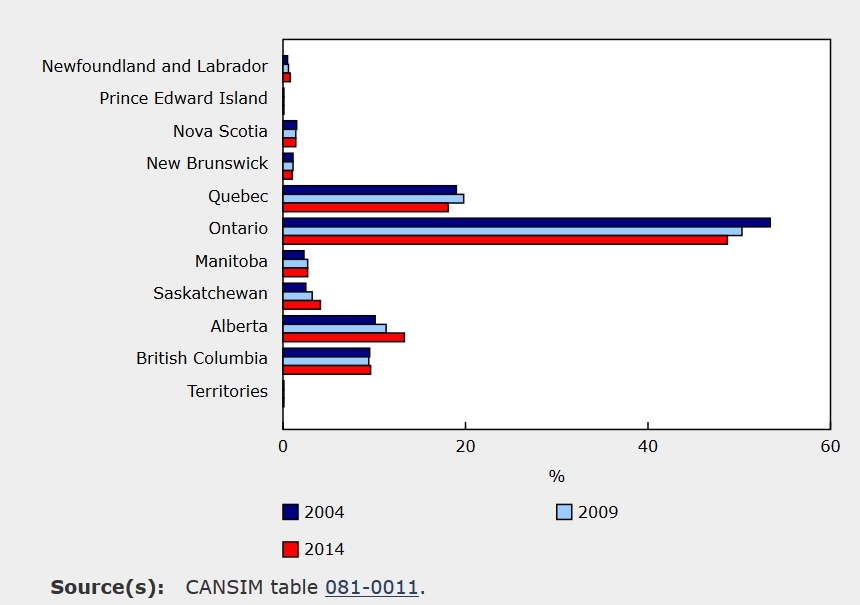
Left: Chart 3 -- Average share of
monthly wholesale sales by subsector; right: Chart 4
-- Average share of monthly wholesale sales by province and for the
territories. Click to enlarge.
Liberals' Persistence in Pushing Anti-Communist Memorial
Monument Will Expose Liberals'
Self-Serving Definitions of Democracy,
Freedom and Human Rights
From February 2-16 the Government of Canada used an online questionnaire to embroil Canadians in participating in the anti-communist memorial project started by Stephen Harper and Jason Kenney.
The Department of Canadian Heritage states that it "invites Canadians from across the country to contribute to the building of their nation's capital by sponsoring commemorations of Canadian ideas, people and events that are of national symbolic importance." The anti-communist memorial project is not a Canadian "idea of national symbolic importance" but a project of an organization comprised of all kinds of unsavoury characters who are either direct supporters of Nazis past and present or descendants of Nazis past and present who claim that they are the true supporters of freedom and democracy because they opposed communism.
The Department of Canadian Heritage calls for support for this private project and in no way explains how it is a "Canadian idea, person or event of national symbolic importance." In an attempt to make it relevant to Canadians, it tries to divert from the anti-communism and claim the project praises Canada as a "land of refuge." It says that "Tribute to Liberty, a not-for-profit organization, is sponsoring a project to build a monument titled Memorial to the Victims of Communism -- Canada, a Land of Refuge."
We are then informed that Canadian Heritage will be launching a national competition to develop a new design for the Memorial, "one that is reflective of the new site," and that the questionnaire is part of "informing the design competition guidelines."
To set the tone for respondents the questionnaire presents egregious distortions which were first put forward by the Harper government as if they are fact. For example, the questionnaire states, "It is estimated that more than 8 million Canadians can trace their origins to countries that suffered under totalitarian communist regimes." In other words anyone whose family left a country at any time which the government asserts had a "totalitarian communist regime," is now memorialized in this project, whether they share the views of the private group pushing it or not.[1]
Through sleight of hand the government then attempts to
hide the wide-ranging opposition to the monument by claiming that the
opposition was only to its placement next to the Supreme Court of
Canada. "Over the past year, many Canadians expressed concerns over the
location of the Memorial, which was to be situated on a large site next
to the Supreme Court of Canada. As a result, the Minister of Canadian
Heritage has requested that a smaller site in downtown Ottawa that is
between 200 and 500 square metres be considered for the Memorial." The
fact is that there has been widespread opposition to the construction
of the monument no matter where it is built.
The Liberals have taken up the project from where the Conservatives left off and hope to divert attention to their own espousal of views on freedom and democracy which are not consistent with the demands of a modern democracy which is called on to uphold the rights of all. Their conception is deeply rooted in Cold War anti-communism which seeks to justify all the crimes the imperialists have committed in their striving for world domination by claiming they stand for freedom, democracy and human rights. According to this conception during the 20th century all problems in the world were caused by communist totalitarian dictatorships and, today, they are caused by Islamic jihadists and terrorists, especially Palestinian and other freedom fighters. By having an alleged competition for a new design and a more appropriate location for the monument they can claim it is a popular venture which represents Canadian values -- a weasel position if there ever was one.
The questionnaire tries to embroil Canadians in selecting answers provided by the government, all of which assume support for the project as a starting point. For example, under the section Monument Objectives, participants are asked to identify which objectives they think are most important:
"Recognize the experience of Canadians who emigrated from communist countries and celebrate their contributions to Canada.
"Commemorate the millions of people worldwide who lost their lives and suffered under communist tyranny.
"Remind visitors about core Canadian values of freedom, democracy and human rights.
"Create awareness of the reality of life under communist regimes."
It's a matter of "heads, Tribute to Liberty wins, tails, you lose."
The other sections of the questionnaire also offer no choice but to share in the dishonesty and extremist views of Tribute to Liberty and the government which is sponsoring their project.[2]
The only place where one could possibly express a dissenting view is in response to the question, "Do you have any thoughts or ideas concerning the design of the Memorial to the Victims of Communism?" Discussing the government's survey on Facebook, many indicate that they used this opportunity to slam the project and demand that it be scrapped altogether. However, because the "consultation" processes the Liberals have undertaken are all private, the outcome is not public knowledge.
The government has pledged $3 million to cover half the costs of this project, even though, try as they might, Tribute to Liberty could never muster any significant financing for it. This is despite its direct endorsement and promotion by former Prime Minister Harper and Jason Kenney in his capacity as Minister of Citizenship and Immigration and several other portfolios. Despite being registered as a charity, Tribute to Liberty was very active in lobbying government in manners deemed inappropriate by the Income Tax Act, and never reported its political activities on its financial returns. Despite the fact that the Harper government went after all kinds of legitimate charities on the most bogus of technicalities, it never questioned Tribute to Liberty's charitable status.
The cause to which this monument is dedicated is bogus and un-Canadian because Canadians never gave their lives in any war so they could espouse the definitions of freedom, democracy and human rights of the Nazis. The more the Liberals push the monument and the more fraudulent the methods they use to declare that it is popular, the more they expose their own pro-Nazi schemes.
Note
1. For more information about the arguments used by Tribute to Liberty and the Government of Canada in support of the monument project, read "Why Harper Government's Anti-Communist Memorial Must Be Scrapped, Not Relocated," TML Weekly, June 6, 2015 - No. 23.
2. Other questions in the survey:
Part 2 - Visitor Experience
Various visitor experiences are considered when designing a new monument. These experiences guide design teams in their creative approach to how visitors will interact with and use the Memorial to the Victims of Communism.
Please identify which of these visitor experiences of the Memorial you think are most important.
You can select up to two of the statements below:
As a gathering space for a commemorative event or ceremony.
As a place for reflection and contemplation.
As a catalyst that prompts discussion and inspires visitors of all ages to learn more about the past.
As a landmark that enhances the visitor's perception of the Capital.
As a place of repose for the public in the downtown core.
Part 3 - Form and Character
The plan is for the Memorial to be built on a site in downtown Ottawa that is between 200 and 500 square metres.
Design teams must consider such factors as the size and characteristics of the site as well as the surrounding environment as they strive to create a design that is integrated with its surroundings. Differing approaches to the relationship between a monument and its setting affect its form and character.
Please indicate your preferred approach for the Memorial, given the proposed location and theme.
You can select one of the statements below:
An impressive monument set in an open space that reflects the scope of the millions affected by communism worldwide.
A human-scaled monument set in an intimate environment that allows visitors to connect to the tragedies at a personal level.
An ensemble of individual components that encourages interaction with the monument as visitors explore the site.
Part 4 - Have Your Say
Do you have any thoughts or ideas concerning the design of the Memorial to the Victims of Communism?
[Type here]
Part 5 - Demographic questions
Do you live in the National Capital Region?
Yes/No
In which province or territory do you live?
[list]
Thank you for your participation!
Uphold the Hereditary, Treaty and Constitutional Rights of Indigenous Peoples
"Design Phase" of National Inquiry into
Missing and Murdered Indigenous Women and Girls Comes to an End
The "design phase" of the National Inquiry into Missing and Murdered Indigenous Women has now come to an end, the three-member government committee announced on February 15. The committee, comprised of Minister of Justice and Attorney General of Canada Jody Wilson-Raybould, Minister of Indigenous and Northern Affairs Carolyn Bennett and Minister of Status of Women, Patty Hajdu, held a three-month consultation with families of victims, Indigenous organizations, human rights groups, and front line workers.
The ministers issued a
press release thanking the more than
2,000 people who participated in 18 consultation meetings. They
expressed being moved by the hundreds of stories they heard from
grieving families and friends of murdered or missing daughters,
mothers, grandmothers, aunts and nieces and their quest for
justice and answers. The press release also noted that people are
still sending in their thoughts and suggestions and that everyone
is invited to do so until February 28.
"The level of engagement clearly demonstrates that Canadians are answering the call for action to address violence against Indigenous women and girls," the press release noted.
This is a questionable statement given that it is not Canadians who are called to action, but the government of Canada and the institutions of the Canadian state which have failed to investigate the crimes against the Indigenous women and girls and in many cases may even be party to those crimes.
One aim of the inquiry, according to the government's announcement, is to "reconcile with the Indigenous peoples." It states, "Our government is committed to real and substantive reconciliation with Indigenous Peoples in the country and the inquiry is an important step in this path to end the unacceptable rates of violence against Indigenous women and girls."
The choice of language is unfortunate indeed since Canadians do not think there is an acceptable rate of violence against women under any circumstances. Are the Liberals comparing the rate of violence against Indigenous women and girls with the rate of violence against non-indigenous women and girls? What they mean is not clear and does not get the National Inquiry off to a very good start.
The Ministers leading the design of the Inquiry have said many times that one of its aims is to get at the "root causes" of murdered and missing Indigenous women and girls but this was already documented by past inquiries such as in the 444 recommendations of the Royal Commission on Aboriginal People in 1996. These recommendations were totally ignored by the Chrétien Liberals in power and the Martin Liberals after them. Many root causes were again documented more recently in the final report of the Truth and Reconciliation Commission in 2015.
Indigenous organizations such as the Native Women's Association of Canada, the Assembly of First Nations and others, human rights groups and victims' families are justifiably concerned that the Liberals may repeat the same again. They are demanding that the main aim of the Inquiry be an end to the killing and disappearance of Indigenous women, to provide justice for the now 4,000 estimated victims[1] and for the Canadian state to provide redress for the families of victims and fund the means of their healing.
They are expressing their resolve to hold the Liberals to their pledge of "a renewed, nation-to-nation relationship with Indigenous peoples in Canada" and a "real and substantive reconciliation" for which the Inquiry is a key initial step. In taking this stand, they are joined by the Canadian and Quebec people who want to hold the Canadian state to account and to end the ongoing crisis of missing and murdered Indigenous women and girls.
On February 17, the Native Women's Association of Canada (NWAC), the Canadian Feminist Alliance for International Action (FAFIA), and the Canadian Journal of Women and the Law (CJWL) released their report and recommendations concerning the design of the national inquiry into murders and disappearances of Indigenous women and girls. This report was the synthesis of the deliberations at a two-day symposium held on January 30 and 31 in Ottawa under the topic "Murders and Disappearances of Indigenous Women and Girls: Planning for Change -- Towards a National Inquiry and an Effective National Action Plan."
The symposium brought together international human rights experts from the United Nations and the Inter-American Commission on Human Rights, Indigenous women leaders, family members, advocates and activists on this important issue from across Canada. The symposium aimed to discuss and put forward proposals to the federal Liberal government to ensure that the National Inquiry on Missing and Murdered Indigenous Women remains true to its aims as defined by the victims, their families and Indigenous peoples across Canada.
Twenty-two recommendations were put forward by the Symposium Report. One of the key recommendations is that the Inquiry be led by Indigenous women who have the knowledge and expertise to do this important work based on four decades of advocating and activism on this question. Another calls for the federal government to ensure that all provincial and territorial governments participate in the Inquiry to ensure that it is truly national in scope and the decisions of the Inquiry are binding on all levels of government.
 The report recommends the
Inquiry "provide a systemic
examination of the causes and consequences of gendered,
sexualized and racialized violence against Indigenous women and
girls including the harm to their families and communities, and
to identify the measures necessary to address them effectively."
It says the Inquiry must "fully address the root causes of
gendered and racialized violence against Indigenous women and
girls, including the systemic and institutionalized devaluing of
the lives of Indigenous women and girls, the harmful impact of
colonial laws and policies, the impunity caused by failures of
law enforcement agencies to diligently investigate and prosecute
violence, the proliferation of sexualized violence and imagery of
sexualized violence, and all other factors that have caused the
past and present structural inequalities and violence against
Indigenous women and girls."
The report recommends the
Inquiry "provide a systemic
examination of the causes and consequences of gendered,
sexualized and racialized violence against Indigenous women and
girls including the harm to their families and communities, and
to identify the measures necessary to address them effectively."
It says the Inquiry must "fully address the root causes of
gendered and racialized violence against Indigenous women and
girls, including the systemic and institutionalized devaluing of
the lives of Indigenous women and girls, the harmful impact of
colonial laws and policies, the impunity caused by failures of
law enforcement agencies to diligently investigate and prosecute
violence, the proliferation of sexualized violence and imagery of
sexualized violence, and all other factors that have caused the
past and present structural inequalities and violence against
Indigenous women and girls."
The Symposium Report calls on the Inquiry to "fully address the colonial context in which violence against Indigenous women and girls occurs and specifically the profound social and economic disadvantage of Indigenous women and girls. In particular, the national inquiry must address the poverty of Indigenous women and their disadvantaged social and economic conditions in housing, food security, education, employment, child welfare, and their over-incarceration."
The central position given to human rights principles is evident in all the recommendations. This includes calling on the Government of Canada to repeal sections of the Indian Act that discriminate against Indigenous women and make them vulnerable, and for the Inquiry to "take a human rights based approach and that its standards, analysis and outcomes will be grounded in human rights, including instruments that set out women's human rights and the rights of Indigenous peoples." It says that the Government of Canada must "implement the recommendations of the United Nations Committee on the Elimination of Discrimination and the Inter-American Commission on Human Rights, which have investigated the murders and disappearances, issued reports, and made concrete recommendations to Canada about how to move forward. These recommendations provide a base line for the inquiry and implementing them must be the first phase of the work of the inquiry."
The final recommendations include calling for a mechanism to ensure that the recommendations of the Inquiry be implemented and monitored to ensure compliance. This process must be funded adequately "to ensure the full participation of Indigenous women and girls, families of missing and murdered Indigenous women and girls, Indigenous women's organizations and other knowledgeable civil society organizations," the Symposium Report said. Another important demand is that a plan and funding be made available to inform everyone about this national issue moving forward.
A copy of the report has been sent to the Liberal
Government
and can be found here.
Note
1. Quoted by Minister for Status of Women Patty Hajdu on February 16, citing research by the Native Women's Association of Canada (NWAC). Latest RCMP figures say that in 2015 an additional 32 women died and another 11 "disappeared."
Thousands Participate in February 14
Memorial Marches

Vancouver
The 26th Annual Women's Memorial Marches took place across the country on the weekend of February 14 to remember the thousands of Indigenous girls and women who have been murdered or gone missing across Canada over the decades. The first march was held in 1991 in Vancouver, in response to the murder of a Coast Salish woman whose death was viewed with disinterest by the authorities and media. Since that time, as more and more such deaths have come to light, the outrage has grown along with the demand that the Canadian state be held to account for the violence it continues to commit against Indigenous peoples. The colonial state refuses to uphold its duty to engage with Indigenous peoples on a nation-to-nation basis. Instead it violates their rights and tears asunder their communities leaving people to fend for themselves, especially leaving women and youth as fair game for exploitation, including by the police forces who are allegedly there to serve and protect the vulnerable. The participation of people from all walks of life made clear that this is an issue facing the entire society. Besides the events in Canada, actions also took place in Minneapolis and Duluth, Minnesota in the U.S.
TML Weekly is posting below are photos and reports from this year's memorial marches.
Vancouver
Some 3,500 people rallied in Vancouver to oppose the ongoing racist violence against Indigenous women. Representatives of the three Coast Salish First Nations -- the Tsleil Watuth, Musqueam and Squamish -- welcomed all participants. It was pointed out that the march was organized and led by Indigenous women because they are the ones who have suffered the most under the racist colonial system. One speaker stated, "We will not ask, we demand that the dysfunctional Canadian government end the violence against Indigenous women." Another called on everyone to "rise up against colonialism and assimilation."
The march through the Downtown Eastside was led by First Nations elders and family members of missing and murdered women. Along the march route short ceremonies, including the laying of roses, were held where victims' bodies were found or where those missing were last seen. At Hastings and Main, a large circle was formed where the families of missing and murdered women gave emotional tributes to their loved ones.





Concern was expressed by all speakers throughout about the police forces and their callous refusal to take crimes against Indigenous women seriously and role in the colonial oppression of Indigenous peoples. Also singled out were governments across Canada for their empty words and token actions. One woman speaker expressed deep skepticism at government inquiries, that "always amount to a bunch of papers which don't do any good." She said that the people who have been fighting for justice must make sure they keep the initiative in their hands and ensure governments are held to account.
Among those who participated in the march were Grand Chief Stewart Phillip, president, Union of BC Indian Chiefs; dozens of chiefs and local Indigenous activists; politicians Jenny Kwan, Vancouver East NDP MP; Melanie Mark Vancouver-Mt Pleasant NDP MLA; Vancouver Mayor Gregor Robertson and Councillor Andrea Reimer; Charles Boylan, spokesperson of the BC regional branch of CPC(M-L) and a Party delegation.
Prince George
More than 200 people marched through the streets of Prince George on February 13 for the city's second Annual Women's Memorial March. Speaker after speaker -- from the Highway of Tears initiative, family members who have lost loved ones, Indigenous Elders, college and university student representatives, organizers of the Moosehide Campaign and others -- all stood as one powerful united voice to end violence against women and particularly Indigenous women.


Victoria


Comox Valley
Comox Valley held its second annual Memorial March on February 14 at Simms Park. It was organized and co-chaired by two young women activists, Kristy Bell and Stasia Hasumi. The rally started with a prayer and speeches by K'omoks chief Rob Everson, a Gitxsan elder, and Vera Wallace, whose sister disappeared in 1971 from Cape Mudge on Quadra Island. Following a welcome dance and women's dance by the Kumugwe Dancers (K'omoks First Nation) there was a march into the downtown area and back to the park where there were more dances in which everyone participated.

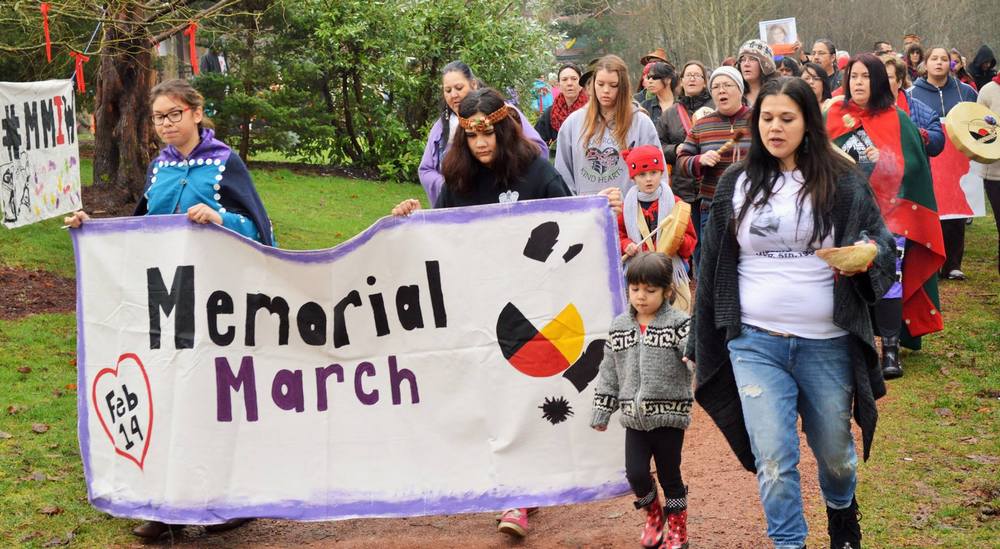
The message from all the speakers was that it is time to end violence against Indigenous women and girls and that it is everyone's responsibility to hold the RCMP and the government to account. Hope was expressed for the National Inquiry but only if it is led by and listens to Indigenous women and communities and addresses the violence of the state and the system of colonial justice.
Edmonton
Calgary

Saskatoon


Winnipeg


Toronto
Close to 200 Indigenous people and their allies including activists of CPC(M-L) gathered outside the headquarters of the Toronto Police on College St. on February 14 to mark the 11th Annual Strawberry Ceremony. The ceremony takes its name from the strawberry's symbolism of womanhood and motherhood in Indigenous traditions.
Speakers remembered family members, friends, sisters, aunts and grandmothers who were murdered or have gone missing with little done to investigate the killing or the disappearance. Many of the speakers pointed out that the reason there is a large number of missing and murdered Indigenous women who are treated as less than human is because of the Canadian colonial state and its indifference and hostility to Indigenous peoples.
Montreal

In Montreal on a bitter cold winter day, some 250 people, mainly youth, gathered outside the St-Laurent metro station. Michelle Audette, co-chair of the collective Missing Justice, welcomed everyone and informed them of the origins of the annual march that began in 1991 in Vancouver. Speakers included Missing Justice co-chair Stacy Gomez, a representative of Adithi (the South Asian Women's Community Centre), as well as a relative of Sindy Ruperthouse, a missing Indigenous woman. Music, song and dance were provided by the Buffalo Hat Singers, MJ Tremblay, Odaya and Barbara Diabo, amongst others.
Poet and singer MJ Tremblay, an Innu woman, spoke of the need for everyone's support to end the victimization of women. "Women are marching. Women continue to march. We must continue to unite, to be able to bring peace to those who have not yet found it, who must never be forgotten," she said. Also participating in the march was a contingent of the Marxist-Leninist Party of Quebec (PMLQ), with placards calling for justice for murdered and missing Native women and the restoration of the hereditary rights of Indigenous peoples.
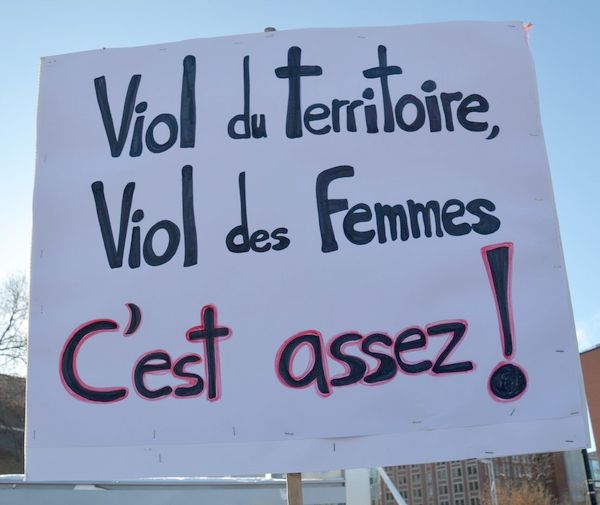

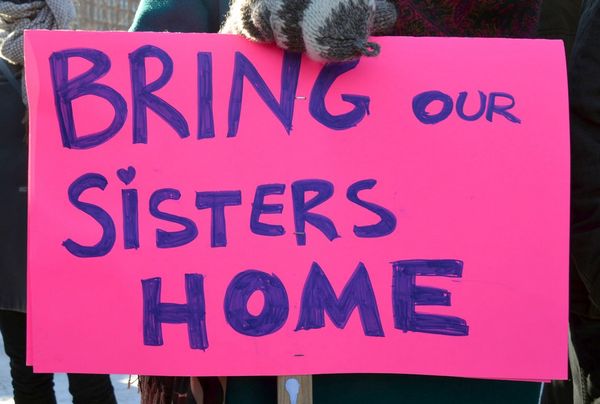

Minneapolis, Minnesota, U.S.



(Photos: TML, L. Boxall, M. Bush, T. Sprackett, S. Stromme, N. Yamchuk, R. Young-McCulloch, JCE Photography)
Thousands of Residential School Victims Denied Compensation by Racist Canadian State
It has come to light that some 3,000 Indigenous people who attended residential schools in the 1950s and 1960s have had their just claims for compensation under the Indian Residential School Settlement Agreement of 2006 (IRSSA) denied on the basis of a technicality.
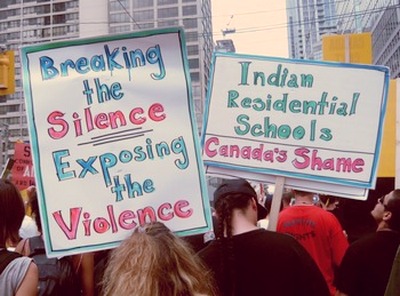 The IRSSA was the result of
the largest class action suit in Canadian history and signed by the
Assembly of First Nations (AFN) and their affiliates, various churches
which administered the
residential schools attended by some 150,000 Indigenous children
from 1876 to 1996, and the federal Conservative government. Its
aim was to compensate and render justice for the victims for the
crimes of abuse suffered by a majority of these Indigenous
children. To date the Canadian government has paid out nearly
three billion dollars to more than 80,000 residential school
survivors, through the Independent Assessment Process (IAP)
established by the IRSSA. The IAP was designed to settle claims quickly
and to be "claimant-centred." The process of settling these claims
began in 2008 after former Prime Minister Harper made a formal apology
and asked on behalf of Canada "for the forgiveness of the Aboriginal
peoples of this country for failing them so profoundly."
The IRSSA was the result of
the largest class action suit in Canadian history and signed by the
Assembly of First Nations (AFN) and their affiliates, various churches
which administered the
residential schools attended by some 150,000 Indigenous children
from 1876 to 1996, and the federal Conservative government. Its
aim was to compensate and render justice for the victims for the
crimes of abuse suffered by a majority of these Indigenous
children. To date the Canadian government has paid out nearly
three billion dollars to more than 80,000 residential school
survivors, through the Independent Assessment Process (IAP)
established by the IRSSA. The IAP was designed to settle claims quickly
and to be "claimant-centred." The process of settling these claims
began in 2008 after former Prime Minister Harper made a formal apology
and asked on behalf of Canada "for the forgiveness of the Aboriginal
peoples of this country for failing them so profoundly."
Two years later, in 2010, Department of Justice lawyers began to argue in compensation hearings that students who attended some 50 schools listed in the IRSSA would no longer be eligible for claims because in the 1950s and 1960s the administration of these schools was taken over by the federal government, a move known as the "administrative split." With the "administrative split" the running of the schools was taken over by federal authorities while the residences continued to be run by the churches. It was argued by these lawyers that any abuse that occurred outside the residences -- in the playgrounds, in the school and so on -- were not going to be recognized or compensated. This is an unconscionable act aimed at violating the terms of the IRSSA and re-opening old wounds and punishing victims all over again.
It is reported in the media that Justice Department lawyers who made the argument to deny the victims compensation were directed to do so from "on high." Rob Nicholson, the Conservative MP for Niagara Falls, who was Justice Minister for the Harper government during this entire period, denies knowing anything about this.
 The Assembly of First
Nations, one of the parties to the IRSSA, has called on the Liberal
government to take immediate action to
address this issue. Perry Bellegarde, Grand Chief of the AFN
pointed out that "it's completely unjust and unfair that
governments would start finding an administrative loophole in
terms of trying to limit their financial obligations. These are
lawful obligations, and it really hurts and further drives pain
for the survivors," he said.
The Assembly of First
Nations, one of the parties to the IRSSA, has called on the Liberal
government to take immediate action to
address this issue. Perry Bellegarde, Grand Chief of the AFN
pointed out that "it's completely unjust and unfair that
governments would start finding an administrative loophole in
terms of trying to limit their financial obligations. These are
lawful obligations, and it really hurts and further drives pain
for the survivors," he said.
TML Weekly condemns this brutal violation of the victims' right to compensation which opens old wounds, and echoes the demands for the Trudeau government to immediately restore compensation to all those affected as well as compensation for their additional suffering and anguish. Measures must be taken as well to investigate who made the decision to deny these claims to establish what legal action can be taken against them.
(With files from the Globe and Mail, Indian Residential School Settlement Agreement.)
New Wapekeka School and the Right of
Indigenous Peoples to a
Modern Education
On February 3, the Ministry of Indigenous and Northern Affairs Canada issued a press statement announcing that the federal Liberal government has built a new school in Wapekeka First Nation to replace the one destroyed by fire in May 2015. The Wapekeka First Nation, a community of 400 Oji-Cree people, is located 600 kilometres north of Thunder Bay, Ontario in the Nishnawbe Aski Nation (NAN) territory.
|
|
The press release quotes Robert Nault, the Liberal MP representing the riding of Kenora in northern Ontario, and former Minister of Indian and Northern Affairs Canada (1998-2003) under the Chrétien Liberals: "This project demonstrates what can be achieved when partners work together in a collaborative spirit towards a mutual goal. Providing the students of Wapekeka First Nation with a culturally appropriate and secure place to learn is paramount to ensuring that they are able to receive a quality education." These are fancy words from Mr. Nault, who did absolutely nothing to help the children of the Attawapiskat First Nation, also in the NAN territory, when their primary school was closed down due to mould and other contamination in 2000. It required that a 13-year old Cree schoolgirl from the community, Shannen Koostachin, lead a national and international political campaign before the federal government was forced into building a new school in Attawapiskat fourteen years later in 2014. Shannen herself was killed in a tragic road accident in 2010 near Timmins, Ontario where she had gone to live in order to complete her high school education.
The Liberals are spinning the news of the opening of the
new Wapekeka school as an example of how they are moving quickly to
address matters related to First Nations education. This should not be
permitted to divert from the objective reality -- that due to decades
of deliberate underfunding from the time of the Chrétien
Liberals to the present, the condition of the majority of schools in
the NAN territory are far from adequate -- an indictment of the
colonial relations between the Canadian state and Indigenous peoples.
About a year ago, on February 7, 2015, then-NAN Deputy Grand Chief Terry Waboose stated: "The majority of Canadians have never seen what passes for a school in most of our communities. They would be shocked if they did. What needs to be stressed is that we don't even have the basics." He noted at the time that five NAN communities did not even have schools. The communities that do have schools, he said, lack what students in most of the rest of the province have -- libraries, arts programs, science labs, adequate amounts of text-books and other supplies. It was pointed out as well that per capita, on-reserve students received $8,000 per year in education funding while students in the rest of Ontario received $13,000. Waboose emphasized that there were two main causes for this. "The first is the chronic underfunding of First Nations schools by the federal government, which has led to the infrastructure gaps between First Nations and other communities. The second is the fact that while First Nations call for self-governance on education, the federal government has a vested interest in keeping the status quo," he said.
Successive federal governments have maintained the status quo by refusing to fully honour the Crown's commitments to the First Nations of the NAN agreed to in Treaty 9 and Treaty 5 signed in 1905 and 1908 respectively. Besides having substandard schools, the children in the territory have to travel south to Timmins or Thunder Bay to attend high school because there are no high schools in their communities. There they have to fend for themselves and deal with isolation and racism without the support of their families and communities, sometimes with tragic results. For example, seven First Nations students, all students at the Dennis Franklin Cromarty High School in Thunder Bay, took their own lives or died of suspicious causes between 2000 and 2011. These tragic deaths are now the subject of an official inquest but whether warranted conclusions will be drawn and redress provided is still an issue.
 Indigenous children living
in northern Ontario have the Treaty right to the highest quality of
education that a modern society like Canada can provide. There is no
reason, for example, that students in remote First Nations communities
cannot stay in their communities to complete their secondary education
through on-line courses, with the support of qualified tutors and other
resources. It is unacceptable that First Nations children and youth,
who represent the fastest growing demographic in Canada, are denied the
basic right to education in their communities as a result of the
refusal of the racist Canadian state and its institutions to honour
Treaty commitments that were made.
Indigenous children living
in northern Ontario have the Treaty right to the highest quality of
education that a modern society like Canada can provide. There is no
reason, for example, that students in remote First Nations communities
cannot stay in their communities to complete their secondary education
through on-line courses, with the support of qualified tutors and other
resources. It is unacceptable that First Nations children and youth,
who represent the fastest growing demographic in Canada, are denied the
basic right to education in their communities as a result of the
refusal of the racist Canadian state and its institutions to honour
Treaty commitments that were made.
The Trudeau Liberals are duty-bound to immediately reverse the egregious underfunding of education and all social programs to First Nations in the NAN territory and across Canada so that all children and their families can live secure and prosperous lives on their own terms. Without guaranteeing necessities such as safe drinking water, proper housing, healthcare, education and other rights, including economic development on the basis of equality and mutual benefit in line with Treaty rights and human rights, the claims of Prime Minister Justin Trudeau and the Liberal government that their aim is to foster nation-to-nation relations will be hollow indeed.
Venezuelan Government and People In
Action to
Defend the Revolution and Counter Economic War
All Out to Defend Venezuela's Achievements Against Their Usurpation by Darkest Reaction!

Venezuelans in action to oppose the resurgence of reactionary forces at
the opening of the National Assembly, January 4, 2016. (TeleSUR)
Venezuela's government and people are taking important measures to defend the country's sovereignty and dignity in the face of the assault of the reactionary forces which have staged a comeback in that country.
To their merit, the achievements of the Venezuelan people and government under Hugo Chávez and Nicolás Maduro are all the more noteworthy given the context of the period of retreat of revolution in which the world has been mired since the 1989-90 period. From 1998 to today they have taken serious measures to right historical wrongs so that the people would no longer suffer the abject poverty, deprivation and racism inflicted on them by one of the most brutal, racist and reactionary oligarchies any country has had the misfortune to be saddled with.
Under the presidency of Hugo Chávez, extensive pro-social measures were taken to raise the standard of living of the people and now that the reactionary oligarchy has managed to make a comeback, President Nicolás Maduro is using his presidency to safeguard the achievements of the Venezuelan Bolivarian process to the best of his ability. Extreme poverty in Venezuela has been reduced from 21 per cent in 1998, the year Hugo Chávez was elected President, to 5.4 per cent in 2015. In December 2015 Venezuela's Great Housing Mission completed its initial goal set in 2011 of providing one million low-cost or free homes to Venezuelans. The importance of similar measures in the fields of health care, education and food sovereignty cannot be overstated.
In the past whenever the country suffered under the rule of such an oligarchy during periods of global economic crises, it was not uncommon for Venezuelans to be massacred when they protested for their rights, as was the case during the Caracazo in 1989. Now, in the context of another crisis and brutal counter-revolutionary actions to disrupt the pro-social measures, such as hoarding of food and disruptions of all sorts, and despite the low prices for Venezuelan oil, the government of Nicolás Maduro is taking extraordinary measures to defend the people's rights.
Now is the time to defend the Bolivarian nation-building project as never before. It is under great threat of being reversed by the reactionary forces which have put everything at their disposal to once again usurp power and put the country's human, material and natural resources back under their control. It is not a time to lose heart but to set a firm direction of how the New can prevail over the Old.
In 1907 when Russia suffered a period of reaction following the crushing of the 1905 revolution, the Great Lenin pointed out: "Every zigzag turn in history is a compromise, a compromise between the old, which is no longer strong enough to completely negate the new, and the new, which is not yet strong enough to completely overthrow the old."
 In an effort to hold on to
the Old, the Venezuelan and
regional oligarchies as well as their U.S. backers are waging
vicious campaigns that include the outright sabotage of the
Venezuelan economy and people's well-being, the subversion of
Venezuela's institutions and popular constitution and unceasing
attempts to undermine the presidency. The vicious campaign being
waged not only shows the necessity to settle historical scores
but puts the lie to the claims of the international financial
oligarchy, institutions and imperialist system of states that
they stand for democracy, freedom and human rights.
In an effort to hold on to
the Old, the Venezuelan and
regional oligarchies as well as their U.S. backers are waging
vicious campaigns that include the outright sabotage of the
Venezuelan economy and people's well-being, the subversion of
Venezuela's institutions and popular constitution and unceasing
attempts to undermine the presidency. The vicious campaign being
waged not only shows the necessity to settle historical scores
but puts the lie to the claims of the international financial
oligarchy, institutions and imperialist system of states that
they stand for democracy, freedom and human rights.
The offensive on the part of the forces of reaction and retrogression clearly shows the direction the forces which stand for the New must take. The need for the working class and people of Venezuela to defend themselves against the revanchism of the brutal oligarchy which has ruled the country in the past with no redeeming features is evident.
TML Weekly calls on all Canadians who see the necessity to defeat the moribund forces which cause nothing but misery and leave nothing but destruction in their wake to step up their support for President Maduro and all those who are closing ranks so as to defend the gains of the Bolivarian process. With the participation of the working class and people of Venezuela, by continuing to build their consciousness and organization, the crisis can be resolved in their favour. The Venezuelan people will deprive the exploiters, oppressors, racists, and brutal revanchists of their power to deprive the people of their modern right to govern themselves and advance their Bolivarian Revolution.
President Maduro Outlines Measures to Strengthen Social Programs and Diversify National Economy
The Venezuelan government and people are taking important measures to overcome a serious economic crisis magnified by the global economic crisis, imperialist oil price war and the ongoing economic war of the Venezuelan and foreign oligarchy to usurp power which seriously undermines the people's well-being.
On January 19 Venezuelan President Nicolás Maduro announced the formation of a 45-member National Council for Productive Economy, composed of ministers, governors, mayors, academics, organizations of working people and collectives and businesspeople. The Council is tasked with confronting the longstanding economic imbalance in the form of over-reliance on petroleum extraction due to the historic failure of the Venezuelan ruling elite to develop a diverse and self-reliant economy.
President Maduro outlined 14 engines on which to base Venezuela's economic growth. These are agri-food; pharmaceuticals and health; industry; exports; communal and social economy; oil; petrochemical; mining; tourism; construction; forestry; military industry; telecommunications and technology, and banking and finance. Maduro outlined the importance of each sector for Venezuela's self-reliance and development. For instance, he emphasized the need to expand forestry and wood processing for "producing double the amount of paper needed in Venezuela for books and newspapers, to export and break the dependency on importing."
In light of the collapse in the price of oil, the sale
of which has paramount importance for Venezuela's national revenue, the
government has also taken measures to defend and strengthen the social
programs on which Venezuelans rely as well as the people's food
sovereignty, which is under constant attack by the oligarchy. President
Maduro announced during a major national address on February 17 changes
to Venezuela's exchange rate, an increase in the domestic price of
gasoline, the implementation of a new tax system, and expansion of
community control over food distribution.
Gas prices will rise from $0.02 per litre, by far the cheapest in the world, to $0.20 per litre, still the cheapest in the world. All revenue will go towards Venezuela's social programs such as education, housing and health care. Maduro informed that oil revenue had plummeted from U.S.$3 billion in January 2014 to U.S.$77 million in January 2016. Changes to the exchange rate of the Bolivar will result in a dual currency with a fixed and preferential exchange rate of ten bolivars per dollar for the food sector, health care and other social programs and national industries to guarantee the people's access to necessities and combat speculation.
President Maduro also announced that the Venezuelan government will work with the Ecuadorean government to implement a tax-collection system similar to the Ecuadorean model to combat tax evasion, fraud and avoidance. Additional tax revenue will also support Venezuela's social programs, Maduro said.
Also in support of Venezuela's food sovereignty, which has been a particular target of the oligarchy's economic war, President Maduro announced that control of the state supermarket chain Abastos Bicentenario will be handed over to local communal councils. The move comes after 55 officials in the supermarket chain were arrested for corruption earlier in February. "Either we have a distributive system run by mafias and parasites, or we change," Maduro said. A new price calculation system will also work to better reflect prices of production in costs for subsidized food items such as cornflour and milk.
Venezuela's national minimum wage will also rise by nearly 20 per cent and workers' food coupons will double. As many as 796,000 vulnerable families will also be provided with direct subsidies through the creation of "Socialist Mission Cards," President Maduro announced. Venezuelans are also beginning a 100-day drive to expand urban agricultural production.
Cuba's Defence of the Revolution
U.S. President to Visit Cuba for
First Time in 88 Years
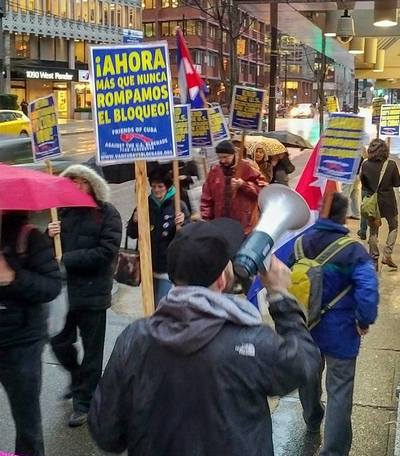

Monthly picket to end the blockade of Cuba at the U.S. consulate in
Vancouver,
February 17, 2016. (Friends of Cuba
Against the Blockade-Vancouver)
U.S. President Barack Obama announced via his Twitter account on February 18 that he will visit Cuba. Reports indicate the visit will take place March 21-22. This will be the first visit of a U.S. president since Calvin Coolidge was there in 1928, the only sitting U.S. president to ever visit the island.
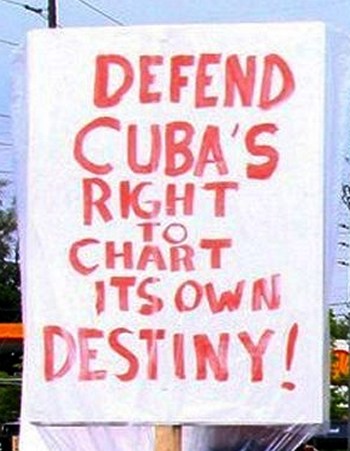 Obama stated that he would
be making the trip "to advance our
progress and efforts that can improve the lives of the Cuban
people." In a statement the same day the White House said, "In
addition to holding a bilateral meeting with Cuban President Raul
Castro, President Obama will engage with members of civil
society, entrepreneurs and Cubans from different walks of
life."
Obama stated that he would
be making the trip "to advance our
progress and efforts that can improve the lives of the Cuban
people." In a statement the same day the White House said, "In
addition to holding a bilateral meeting with Cuban President Raul
Castro, President Obama will engage with members of civil
society, entrepreneurs and Cubans from different walks of
life."
Obama told Yahoo News in December 2015 that he hoped to visit Cuba in 2016, "If, in fact I with confidence can say that we're seeing some progress in the liberty and freedom and possibilities of ordinary Cubans." Obama said he would "love to use a visit as a way of highlighting that progress."
The progress referred to relates to the normalizing of relations between the two countries, which began on December 17, 2014 after five decades of outright hostility from the U.S. The trip is viewed as a way to cement this important aspect of Obama's presidency.
The visit of a U.S. president to another country falls within the realm of "conventional diplomacy" but more than 50 years of unmitigated U.S. belligerence towards Cuba makes this visit exceptional. The U.S. has now been forced to change its policy because of the resilience of the Cuban Revolution and its refusal to renounce its right to self-determination and the principles on which the Revolution is based.
The announcement of the visit has elicited debate within the U.S. ruling circles as well as a lot of acrimony on the part of the Cuban mafia which resides in Miami and elsewhere in the U.S. The trip is also a matter of dispute in U.S. ruling circles in the context of the ongoing U.S. presidential election campaign. Two of the candidates for the Republican Party nomination, Marco Rubio and Ted Cruz, are of Cuban background and oppose the normalization of relations and any easing of the U.S. blockade against Cuba. Both condemned the news that Obama will visit the country.
Cuban officials said they would welcome a visit by the U.S. president but reiterated their longstanding position that Obama should not attempt to interfere in Cuba's internal affairs.
In related developments, although the criminal U.S. blockade of Cuba remains the major impediment to both trade and normalizing relations as well as the U.S. occupation of Cuban territory in Guantanamo, a number of recent announcements underscore Cuba's successes on the diplomatic front.
On February 16, Cuban Minister of Transportation Adel Yzquierdo signed an agreement with U.S. Transportation Secretary Anthony R. Foxx in Havana to allow up to 110 commercial flights between Cuba and the U.S. per day. The deadline for carriers to apply is March 2 and the successful airlines could be announced in summer 2016. Yzquierdo said the agreement marks the beginning of a new stage in bilateral relations between the two countries.
 Cuba and the U.S. have also
agreed to the establishment of a
U.S.-citizen-owned factory at the Mariel Special Development Zone
in Cuba, which will produce tractors and other equipment for use
by Cuban farmers. The Cleber LLC factory will assemble
commercially-available parts into 25-horsepower tractors and cost
less than U.S.$10,000. Access to affordable farm machinery has
been severely restricted by the U.S. blockade causing
problems for Cuban farmers.
Cuba and the U.S. have also
agreed to the establishment of a
U.S.-citizen-owned factory at the Mariel Special Development Zone
in Cuba, which will produce tractors and other equipment for use
by Cuban farmers. The Cleber LLC factory will assemble
commercially-available parts into 25-horsepower tractors and cost
less than U.S.$10,000. Access to affordable farm machinery has
been severely restricted by the U.S. blockade causing
problems for Cuban farmers.
Cuba's Minister of Foreign Trade and Investment, Rodrigo Malmierca visited Washington, DC as part of a delegation which included Orlando Hernández Guillén, President of the Cuban Chamber of Commerce. The trip included meetings with the U.S. Chamber of Commerce as well as other figures, including a meeting between Malmierca and U.S. Secretary of State John Kerry on February 18.
Malmierca used the occasion to reiterate the call for an end to the U.S. economic, commercial and financial blockade which constitutes the main obstacle to building economic and diplomatic links. Orlando Hernández Guillén stated that once the U.S. lifts its sanctions on Cuba there will be important areas for trade and U.S. investments will be welcomed so long as they are consistent with the national interests and sovereignty of Cuba.
The example of Cuba and its diplomatic victories illustrates that small and less powerful nations do not have to subordinate themselves to U.S. imperialism and the big powers. Cuba shows that victories can be defended so long as the people are organized and determined to defend their independence and nation-building projects.
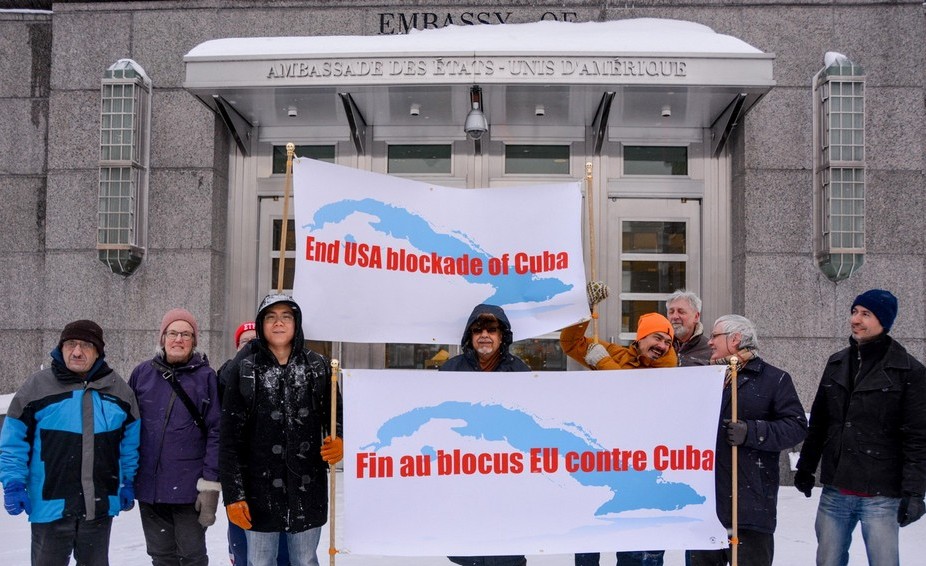
Monthly picket against the blockade at the U.S. Embassy, Ottawa,
February 17, 2016.
Building the Largest Logistical Platform
in the Americas

Mariel Port, Cuba
It is a well-known fact that real and great hopes for the development of the Cuban economy lie in the Mariel Special Development Zone (ZEDM), the first such zone created on the island. It is also well-known that the ZEDM is an ideal space for foreign investment and industrial development, and that Mariel, with one of the best natural ports in the region, is aiming to become the most important logistical hub in the Americas.
The economic, commercial and financial blockade imposed on the island by the United States makes it a challenge to exploit Mariel's full potential in order to transform it into a world class logistical platform.
Located close to several airports and with the construction of highways and train lines, the port of Mariel includes a multimodal transport system that opens the ZEDM up to the world.

The Mariel Container Terminal S.A. (TCM) is among the first to begin operating in the ZEDM. It exploits the benefits of a safe deep water port located in the heart of global maritime trade traffic and is able to receive up to 824,000 TEUs (20 foot container units) per year.
After operating for almost 24 months, the modern TCM is gradually evolving, responding to growing demand. This Cuban mercantile entity, managed by PSA International of Singapore (a world leader in port development, investments and operations) has been handling over 80% of all Cuban container traffic since 2014.
According to TCM Director General Charles A. Baker, the facility took on shipping services from the old Havana Container Terminal over a period of six months and had to train operators with little or no previous experience in port activities.
The British specialist explains that after operating for two years with a staff of mostly young workers, the terminal's standards have improved, as employees learn to use new technologies, through training and innovation.
A Review of the Indicators
With these improvements in the quality of work, the center, which in 2014 completed an average of 18 crane movements per hour in the process of loading and unloading ships, today makes 26 per hour with the potential for more.
Baker expressed his satisfaction given such achievements, noting that the TCM is among the top of its kind in the world. "These levels will rise once we receive larger ships," he adds. The current maximum length is 203 meters.
According to the expert, the bigger the ship, the faster the unloading process, given that the cranes move less during the operation. "On big ships, the work is carried out as if on top of a building."

The situation will be different in 2016, when the dredging of the port of Mariel is scheduled to begin and the expansion of the Panama Canal completed. Cuban waters will then be able to receive the largest ships on the planet (Panamax and New-Panamax), on their way to other destinations.
Currently 8% of the cargo that arrives at the Port of Mariel is diverted to the port at Santiago de Cuba and, according to Baker, the further development of Mariel as a deepwater port, receiving huge ships there, is what will really transform Mariel into an international transshipment hub.
Another of the main indicators which demonstrates the efficiency of the TCM is the 44 minutes it takes for a truck to enter and leave the terminal, a process which took three hours at the old terminal, emphasized Baker.
The director of the facility states that in the coming months and in collaboration with the Republic of Cuba's General Customs, these times and the number of administrative procedures will be reduced through the TCM's fully automated processing system.
The ZEDM is also looking to reduce waiting times -- which are still greater than similar facilities in Europe and Asia -- in order to prevent backlogs. Nonetheless, Baker highlighted the organization of transport as one of the strong points of the process.
Inside the TCM

The Mariel Container Terminal received the equivalent of more
than
300,000 shipping containers worth of cargo in 2015.
Four TCM cranes, able to support up to 85 tonnes, operate on the 702 meter (maximum length 2,400 meters) dock, while another 12 are stationed in the adjoining 27 hectare courtyard.
To the state-of-the-art equipment must be added a sophisticated surveillance system, machines to move empty, refrigerated or oversized TEUs as well as a railway line to transport both containers and passengers to Ciego de Ávila.
Among the biggest importers in 2015, Baker highlighted, is the network of TRD Caribe stores, Cimex and Alimport, while the largest shipping lines included the Cuban entity MELFI, Italian company MSC, Maersk Line of Denmark and the French CMA CGM. He noted that this year the port received almost 100,000 containers more than in 2014.
Given that maritime transport continues to be the most economic means of large-scale trade transportation, the TCM is aiming to transfer goods to the Dominican Republic, Jamaica, Haiti, Mexico and other Central American countries, while it remains excluded from the U.S. market, the TCM director stated.

New York Governor Andrew Cuomo (third from left) visits the
Mariel Port, April 21, 2015.
(Granma International. Photos: Granma, ZDE Mariel website. Edited slightly for grammar by TML.)
Anniversary of Assassination of Malcolm X
Reflections on Malcolm X's Legacy

February 21, 2016 marks the 51st anniversary of the assassination of Malcolm X, who later took the name El-Hajj Malik El-Shabazz after his pilgrimage to Mecca in 1964. As a revolutionary internationalist and a leader of the Black liberation struggle, Malcolm X shaped and influenced a generation of Black activists, artists, revolutionaries and intellectuals. His impact has been profound and lasting. The anniversary of his assassination is, therefore, a time for serious contemplation on his legacy.
While alive, Malcolm X faced an unrelenting vilification from the ruling circles; in death, the same forces that denounced him attempt to transform him into a benign symbol palatable to imperialist and neo-liberal palates; he is now praised by those same powers that once condemned him. As V.I. Lenin poignantly noted in his seminal The State and Revolution:
"During the lifetime of great revolutionaries, the oppressing classes have invariably meted out to them relentless persecution, and received their teaching with the most savage hostility, most furious hatred, and a ruthless campaign of lies and slanders. After their death, however, attempts are usually made to turn them into harmless saints, canonising them, as it were, and investing their name with a certain halo by way of 'consolation' to the oppressed classes, and with the object of duping them, while at the same time emasculating and vulgarising the real essence of their revolutionary theories and blunting their revolutionary edge."
So it is with Malcolm X. The pervasive and dominant narrative freezes in place Malcolm's politics and philosophy, transfixing his thinking to the 12-years he served in the Nation of Islam, when he was under the authority of its leader Elijah Muhammad. While, acknowledging his rupture with the most race essentialist and absurd theological/ideological tenets of the Nation of Islam (especially the white devil thesis), Malcolm X is crafted as a crude and unsophisticated ultra-Black nationalist. Moreover, the significance of his legacy is often reduced to a personal odyssey, an individualistic ethos illustrating what someone can do by sheer force of will to transform their life. In this mangling of historical memory, the further development of his political and intellectual thinking from 1964 to 1965 disappears. His unremitting efforts to build an organization to reflect and realize those new political goals are disregarded. In short, the subsequent development of his thinking on capitalism and imperialism are ignored, if not erased.
Malcolm X: The Anti-Imperialist and Anti-Capitalist
|
|
Malcolm X was part and parcel of the wave of anti-colonial, national liberation and anti- imperialist struggles that swept Africa, Asia, Latin America and the Caribbean in the 1950s and 1960s. He challenged U.S. exceptionalism by clearly placing the African American liberation movement within the global anti-colonial struggle. By locating the Black liberation struggle within an internationalist context, he saw the internationalist perspective as indispensable to advancing the fight for justice in the United States. On February 4, 1965 in his address to youth in Selma, Alabama he stated: "I pray that you will grow intellectually, so that you can understand the problems of the world and where you fit into, in that world picture." On February 18, 1965, he went further stating that the Black liberation struggle was "part of the rebellion against the oppression and colonialism that has characterized this era..." He further argued: "It is incorrect to classify the revolt of the Negro as simply a racial conflict of black against white, or as purely American problem. Rather, today we are seeing a global rebellion of the oppressed against the oppressor, the exploited against the exploiter."
Malcolm's repudiation of a race-only analysis was captured in a January 1965 television interview, where he declared:
"I believe there will ultimately be a clash between the oppressed and those who do the oppressing. I believe that there will be a clash between those who want freedom, justice, and equality for everyone and those who want to continue the systems of exploitation. I believe that it will be that kind of clash, but I don't think it will be based on the colour of the skin, as Elijah Muhammad has taught it."
Malcolm assumed an uncompromising anti-imperialism, embodied by trenchant criticism of the West. The West's interests, he declared are inextricably tied to "imperialism, colonialism, exploitation, racism..." He went further extending his burgeoning anti-imperialism to a searing critique of capitalism, the system undergirding Western imperialism. Malcolm argued: "You can't have capitalism without racism... You can't operate a capitalistic system unless you are vulturistic; you have to have someone else's blood to suck to be a capitalist..." He viewed racist oppression and exploitation of African-Americans as deeply entangled with U.S. aggression abroad, and this oppression and exploitation and warmongering were (are) the products of the capitalist system.
The False Dichotomy
In examining the development of Malcolm's thinking also, it bears reflecting on the supposed unbridgeable divide between him and Martin Luther King, Jr. Each is portrayed as the other's antithesis. This distortion deliberately ignores and erases that King's views increasingly embodied many of the political positions that Malcolm had advocated in the last years of his life.
King's understanding of the nature of U.S. society moved along the same lines as Malcolm X. In the years following the March On Washington, King augmented his eloquent and poignant "I Have a Dream" vision with a deepening opposition to Washington's foreign policy and to the economic system that produced aggression abroad and inequality and poverty at home.
King firmly opposed the war in Vietnam. His opposition was not simply a powerful moral stance, but one that tied Washington's aggression to a system that produced, maintained and required great disparities of wealth and power between a privileged few and the disenfranchised vast majority. He observed: "When machines and computers, profit motives and property rights are considered more important than people, the giant triplets of racism, militarism and economic exploitation are incapable of being conquered."
 King understood that while the
Civil Rights Movement had
won
important victories, these victories could not be permanent as
long as the underlying structural roots of inequality, poverty
and racism were not fundamentally altered. In short, capitalism
had to be radically transformed. In a 1967 speech to the Southern
Christian Leadership Conference, King unequivocally articulated
this analysis:
King understood that while the
Civil Rights Movement had
won
important victories, these victories could not be permanent as
long as the underlying structural roots of inequality, poverty
and racism were not fundamentally altered. In short, capitalism
had to be radically transformed. In a 1967 speech to the Southern
Christian Leadership Conference, King unequivocally articulated
this analysis:
"One day we must ask the question, 'Why are there forty million poor people in America?' And when you begin to ask that question, you are raising questions about the economic system, about a broader distribution of wealth. When you ask that question, you begin to question the capitalistic economy. And I'm simply saying that more and more, we've got to begin to ask questions about the whole society. We are called upon to help the discouraged beggars in life's market place. But one day we must come to see that an edifice, which produces beggars, needs restructuring. It means that questions must be raised. You see, my friends, when you deal with this, you begin to ask the question, 'Who owns the oil?' You begin to ask the question, 'Who owns the iron ore?' You begin to ask the question, 'Why is it that people have to pay water bills in a world that is two thirds water?' These are questions that must be asked."
King's political practice and strategy reflected his new analytical appreciation of the interconnection of racism, oppression, inequality and capitalism. In the last year of his life, he was organizing the Poor People's Campaign, which sought to achieve a fairer and more equitable society through a united movement of Black and white workers, of all the exploited and oppressed in the United States. While the Poor People's Campaign aimed for peaceful reform of the capitalist system, it was a potent challenge to the ideological and ideational hegemony of capitalism, which was reflected by the wholesale condemnation of King by U.S. ruling circles.
At the end of their lives (King was assassinated on April 4, 1968), Malcolm X and Martin Luther King had become trenchant opponents of capitalism and imperialism. When they were killed, each was in the midst of organizing the people to challenge the system. The goal -- the Promised Land -- was the creation of a better world, one fit for human beings. While the Promised Land has yet to be reached -- and, for some, envisioned -- the struggle for a better world endures.
Website: www.cpcml.ca Email: editor@cpcml.ca


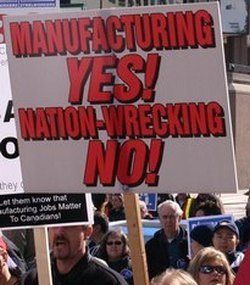
 The new Liberal government
says everything wrong with the
economy and public finances is the fault of the prior
Conservative government. Meanwhile, both parties quarrel over the
looming federal budget deficit, with estimates saying it will be
bigger than ever. The government and opposition claim that the
facts as they see them are on their side and support their
particular sorcery. Where they both agree is on the need to
continue the anti-social austerity agenda.
The new Liberal government
says everything wrong with the
economy and public finances is the fault of the prior
Conservative government. Meanwhile, both parties quarrel over the
looming federal budget deficit, with estimates saying it will be
bigger than ever. The government and opposition claim that the
facts as they see them are on their side and support their
particular sorcery. Where they both agree is on the need to
continue the anti-social austerity agenda.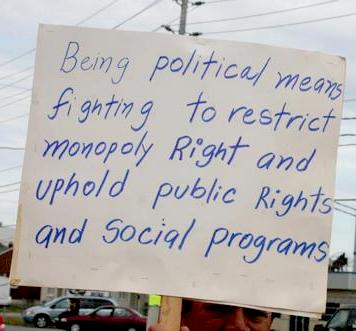 The demands of working
people across the country, who are
every day grappling with economic insecurity and attacks on their
livelihood, can be expressed very clearly:
The demands of working
people across the country, who are
every day grappling with economic insecurity and attacks on their
livelihood, can be expressed very clearly:
 From coherence in
determining prices of production also
arises
the possibility of coherence in making government claims on the
production of value to meet the country's collective needs. This
would arise from the demand for transparent and scientific
accounting of all aspects of the production process. The
incoherence in pricing is a problem that constantly creates
crises in the Canadian economy such as now with oil prices and
with the prices of most natural resources and basic commodities.
For example, as U.S. Steel workers point out the price of steel
has plummeted recently from $700 per ton to $350 greatly adding
to the crisis in the sector. A public authority in the wholesale
trade sector could bring coherence and stability to prices and
use its legal authority to enforce those prices throughout the
economy.
From coherence in
determining prices of production also
arises
the possibility of coherence in making government claims on the
production of value to meet the country's collective needs. This
would arise from the demand for transparent and scientific
accounting of all aspects of the production process. The
incoherence in pricing is a problem that constantly creates
crises in the Canadian economy such as now with oil prices and
with the prices of most natural resources and basic commodities.
For example, as U.S. Steel workers point out the price of steel
has plummeted recently from $700 per ton to $350 greatly adding
to the crisis in the sector. A public authority in the wholesale
trade sector could bring coherence and stability to prices and
use its legal authority to enforce those prices throughout the
economy.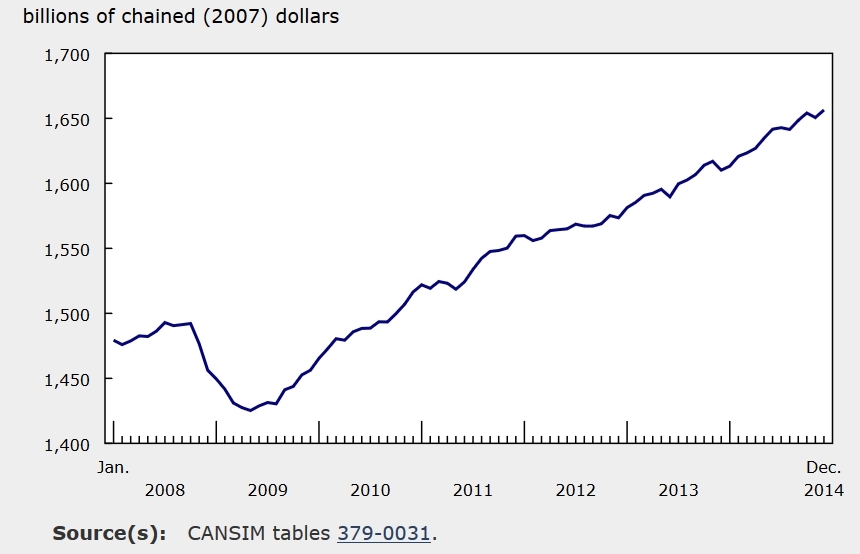
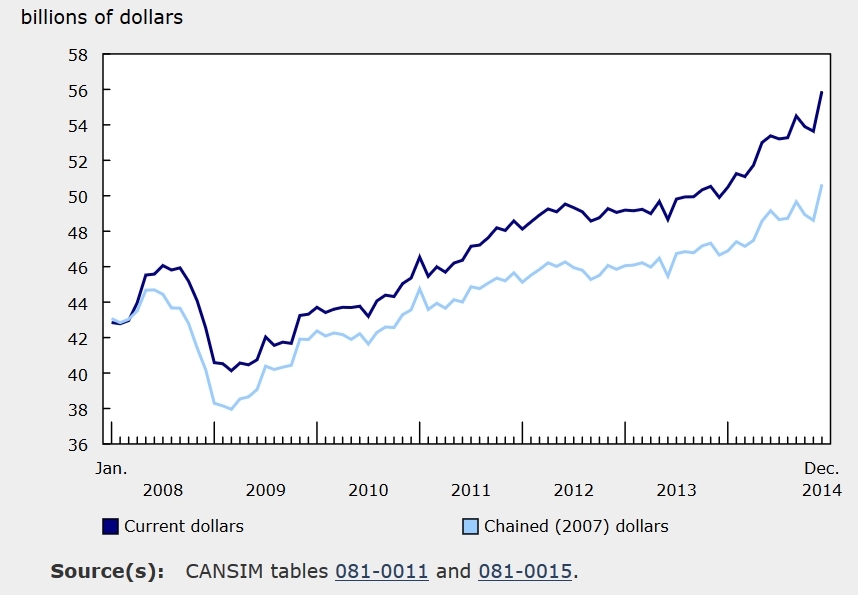 Chart 2:
Wholesale sales.
Chart 2:
Wholesale sales. 